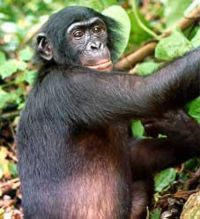Difference between revisions of "Bonobo"
m (→Anatomy and Behavior: typo) |
m (→Anatomy and Behavior: typo; also, the terminology is wrong) |
||
| Line 7: | Line 7: | ||
Proponents of evolutionary psychology often point to bonobos as examples of an evolutionary adaptation in which a species acquired the strategy of bartering sex to enhance social status or to resolve disputes<ref>[http://songweaver.com/info/bonobos.html Bonobo Sex and Society]</ref>. | Proponents of evolutionary psychology often point to bonobos as examples of an evolutionary adaptation in which a species acquired the strategy of bartering sex to enhance social status or to resolve disputes<ref>[http://songweaver.com/info/bonobos.html Bonobo Sex and Society]</ref>. | ||
| − | The American Psychiatric Association taught for decades that homosexuality is a mental disorder that can be treated, until political pressure compelled it to change its view. The National Association for Research & Therapy of Homosexuality (NARTH) points out that the bonobo behavior is not sexual but rather are aggressive acts to assert dominance much like when a dog mounts a person's leg.<ref>Luiz Sérgio Solimeo, [http://www.narth.com/docs/animalmyth.html "The Animal Homosexuality Myth,"] NARTH.</ref> Yet homosexual activists have claimed that bonobos are examples of animals who sometimes perform homosexual acts<ref> Chris Bull, [http://www.findarticles.com/p/articles/mi_m1589/is_n735/ai_20164884 Monkey love - homosexual behavior in primates,] The Advocate, June 10, 1997.3</ref><ref>Steve Sailer, [http://www.findarticles.com/p/articles/mi_m1282/is_1999_Sept_27/ai_55820853 "Chimps and Chumps : What monkeys don't tell us about man,"] National Review, Sept 27, 1999.</ref> | + | The American Psychiatric Association taught for decades that homosexuality is a mental disorder that can be treated, until political pressure compelled it to change its view. The National Association for Research & Therapy of Homosexuality (NARTH) points out that the bonobo behavior is not sexual but rather are aggressive acts to assert dominance much like when a dog mounts a person's leg.<ref>Luiz Sérgio Solimeo, [http://www.narth.com/docs/animalmyth.html "The Animal Homosexuality Myth,"] NARTH.</ref> Yet homosexual activists have claimed that bonobos are examples of animals who sometimes perform homosexual acts,<ref> Chris Bull, [http://www.findarticles.com/p/articles/mi_m1589/is_n735/ai_20164884 Monkey love - homosexual behavior in primates,] The Advocate, June 10, 1997.3</ref><ref>Steve Sailer, [http://www.findarticles.com/p/articles/mi_m1282/is_1999_Sept_27/ai_55820853 "Chimps and Chumps : What monkeys don't tell us about man,"] National Review, Sept 27, 1999.</ref> |
| − | + | It is also common for adult bonobos to have sex with juvenile bonobos.<ref>De Waal, F. (1990). Sociosexual behavior used for tension regulation in all age and sex combinations among Bonobos. In J. Feierman (Ed.), Pedophilia: Biosocial dimensions (pp. 379–393). New York: Springer.</ref><ref>{{cite web|url=http://ngm.nationalgeographic.com/2013/03/125-bonobos/quammen-text|title=The Left Bank Ape|author=Quammen, David|publisher=National Geographic|date=March 2013}}</ref> | |
== References == | == References == | ||
Revision as of 14:39, March 9, 2014
Bonobos, or "pygmy chimpanzees", are an endangered[1] ape species in the genus Pan (the only other being the common chimp). Bonobos are more peaceful and social than the common chimpanzee. Bonobos share about 98% of their DNA with humans and slightly more than the common chimpanzee shares with humans.[2] Unlike many other apes, they walk upright a signficant fraction of the time.
Anatomy and Behavior
Females are smaller than males but unlike in many other ape species the female hierarchy of dominance matters more than that of the males. Bonobos pass the mirror test and have facial expressions close enough to those of humans such that humans can often recognize what emotion a bonobo is expressing. [2] Individual bonobos also have very different facial features such that humans can easily differentiate one bonobo from another.
Proponents of evolutionary psychology often point to bonobos as examples of an evolutionary adaptation in which a species acquired the strategy of bartering sex to enhance social status or to resolve disputes[3].
The American Psychiatric Association taught for decades that homosexuality is a mental disorder that can be treated, until political pressure compelled it to change its view. The National Association for Research & Therapy of Homosexuality (NARTH) points out that the bonobo behavior is not sexual but rather are aggressive acts to assert dominance much like when a dog mounts a person's leg.[4] Yet homosexual activists have claimed that bonobos are examples of animals who sometimes perform homosexual acts,[5][6]
It is also common for adult bonobos to have sex with juvenile bonobos.[7][8]
References
- ↑ PrimateInfo.Net
- ↑ 2.0 2.1 Bonobos at the Columbus Zoo
- ↑ Bonobo Sex and Society
- ↑ Luiz Sérgio Solimeo, "The Animal Homosexuality Myth," NARTH.
- ↑ Chris Bull, Monkey love - homosexual behavior in primates, The Advocate, June 10, 1997.3
- ↑ Steve Sailer, "Chimps and Chumps : What monkeys don't tell us about man," National Review, Sept 27, 1999.
- ↑ De Waal, F. (1990). Sociosexual behavior used for tension regulation in all age and sex combinations among Bonobos. In J. Feierman (Ed.), Pedophilia: Biosocial dimensions (pp. 379–393). New York: Springer.
- ↑ Quammen, David (March 2013). The Left Bank Ape. National Geographic.
